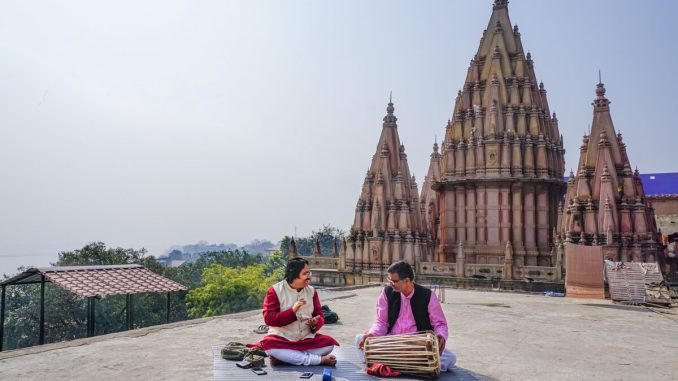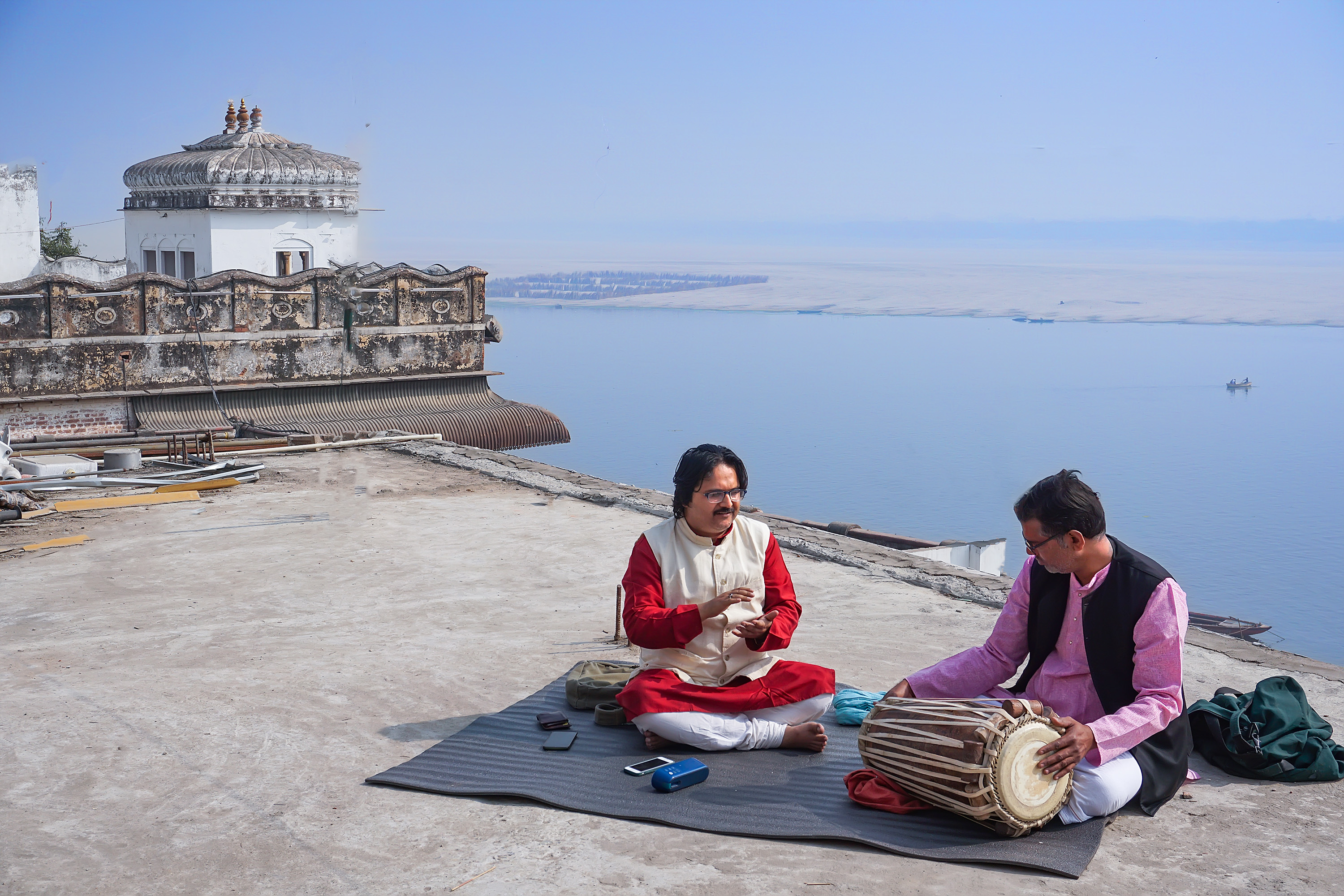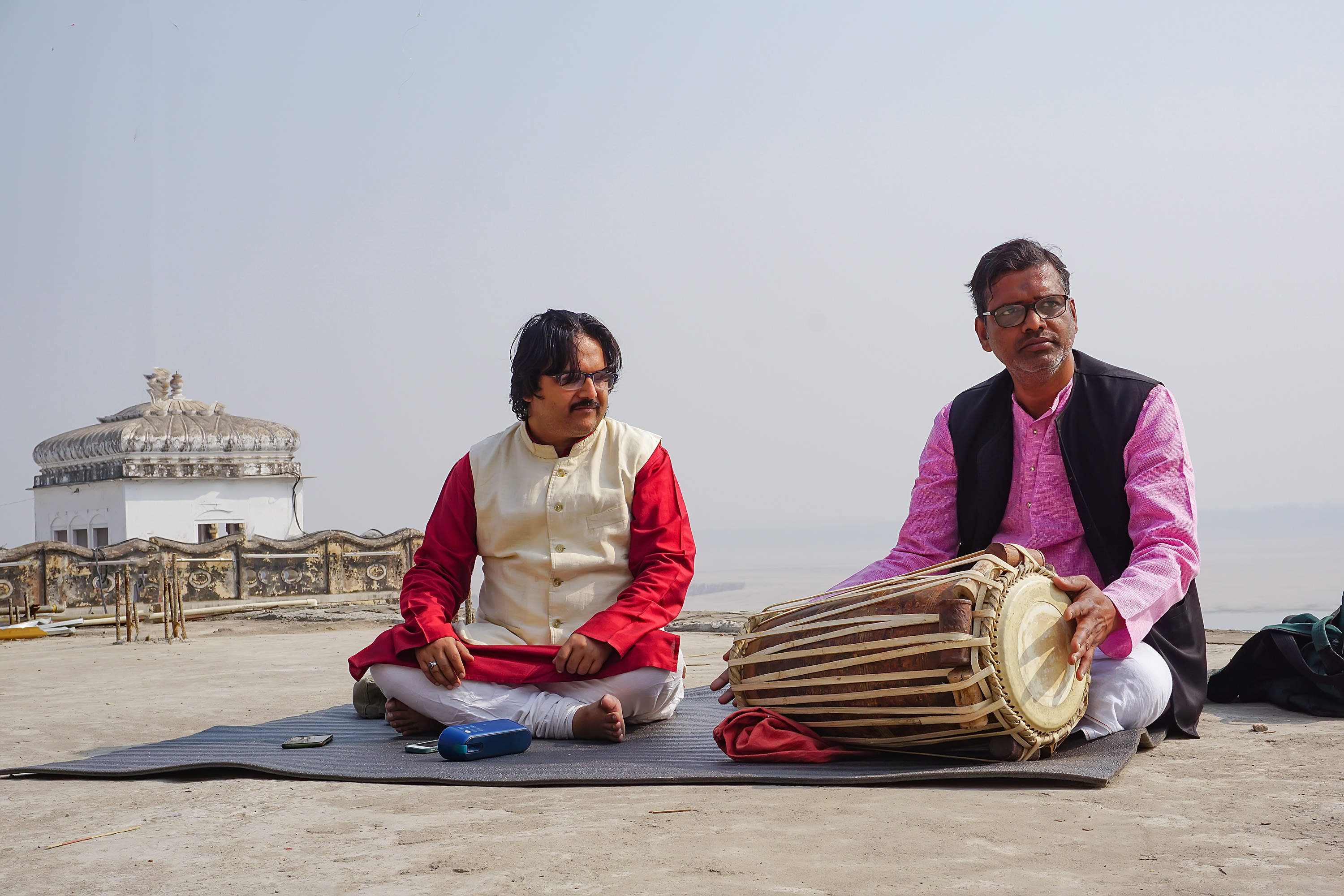
VARANASI—Supriyo Maitro is an A-graded vocalist in the most ancient tradition of classical Indian music, “Dhrupad.” He has sung on the television and on the radio, performed before large audiences, yet he hasn’t experienced what the best in his field have described in the tradition—a divine path that seekers call “sadhana” in India’s yogic traditions.
Sadhana simply means the cultivation of one’s spirit for self-realization, and Dhrupad, whose origin can be found in one of the oldest scriptures, the “Sama Veda,” has been used as a meditative tool.
For Indian musicians like Maitro who want to keep learning after having learned everything, this aspiration for self-realization—for improvement in his spiritual cultivation—is natural. It’s this wish that brought him to the ghats (banks) of the Ganges in the ancient city of Kashi, also known by the modern name of Varanasi.
Kashi, an ancient city of paradoxes, where people have been coming for death, knowledge, and enlightenment in the Buddhist and Jain religions, as well as the Brahmin and other Hindu systems, are replete with stories of meditators, classical musicians and Sanskrit scholars, and even Western artists and seekers who sought similar self-realization—the latest that the Indian media has flaunted are appreciators and aspirants from Hollywood.
How does one have the nerve to dare risk success in one’s career and in the marketplace and leave behind comforts in search for the spirituality of classical music? Maitro sees a rational link: “If the mango doesn’t have skin, how can it hold the flesh inside. Some people limit their comprehension by considering the mango to be just its skin,” Maitro told The Epoch Times in a metaphorical style in Hindi.
In other words, what’s learned superficially is never the truth—the truth can’t be achieved by mere superficial comprehension.
On the iconic Assi Ghat of Kashi which is either crowded with devotees or those performing death rituals, Maitro has a noted accomplice: Ravishankar Shukla, a priest who plays the “pakhawaj,” a barrel drum that’s shrouded in antique traditions and is believed to be originally played by the god Ganesha, the Hindu god of knowledge personified by an elephant-headed form.
“The first generation that belonged to Dhrupad said that it’s god created. After that trend started the light and the folk,” said Shukla. Light classical music offers recent derivatives of classical music and a rich, varied genre. Folk music is older than light classical, and is diverse, sung in local languages and dialects.
“Long back it was practiced in the ‘mandir’ (temples). Only the vedas were chanted, especially the Sama veda. Music was not the motive then, chanting was the motive,” said Maitro, explaining that traditionally chanting was done with technically defined meters, intonations, and “swaras” (musical notes). “It was systematized. You see the Sanskrit meter, very disciplined.”
Vedas, the oldest classical Sanskrit literature, were transmitted in their original forms orally, and this oral tradition was highly codified and refined—today to a non-practitioner these chants may sound musical but that’s how originally these were passed down.

At that time only three musical notes (swaras) were there, and this was followed by the sama veda, which was followed by “prabandh” (composition written for gods, based on stories from mythology), according to Maitro, who quoted from an ancient musical treatise of India.
Maitro and Shukla sit in a small room of 10×10 feet linked by a narrow staircase stretching like a spine through many floors that temporarily house the devotees who come to Shukla and his family of traditional priests for death and after-death rituals.
While Maitro starts the electric “tanpura,” a box that’s a digital version of a string instrument that is used in all Indian classical music traditions, Shukla surprisingly kneads wheat flour into a dough.
“The kneaded dough is applied on the center of the smaller, right face of the pakhawaj to bring out the deep bass sound,” said Shukla, an accomplished musician. It takes a “whole lifetime” to learn to knead the dough with the right consistency for pakhawaj, said Maitro.
India has mystic music traditions. There are existing temples where music is embedded into carved stone pillars that play varied classical instrumental music when stuck, a music-architectural technique that has no known practitioners today.
The most popular among these musical monuments is the 15th century, Sri Vittala Temple in Hampi. It has 56 musical pillars.
When reminded of how the kneaded wheat dough of the density that makes bread is used to tune a pakhawaj and how matter and music could be interchangeable, as is visible in the musical pillars, Shukla smiles and nods in affirmation.
With tanpura’s hymnic resonance and pakhawaj’s deep bass picking up, Maitro’s voice breaks into raga Yaman, a classical melody sung specifically at dusk and one of the first to be taught to learners of Dhrupad.
Maitro defines raga as “roughly the classical melody” but says it’s much more than that. “To me, it’s ordered intuition, and it’s very difficult to explain. It’s a basic quantum of Indian music. It’s like a grammatical rule that helps to intuit music.”
There is an infinite number of ragas in Dhrupad, he said. “They have been classified into different numbers in different traditional texts. But musicians continue to compose new ragas.”
Raag Yaman by Supriyo Maitreyi:
Culture of Music
Outside Shukla’s home, there’s always the hustle-bustle of an Indian pilgrimage town—amidst traffic honking, a flute seller plays melodious music, while every evening priests line up on the Assi Ghat for prayers that include Sanskrit chants, massive lamps, bells, and cymbals.
Maitro, who also teaches music, said he has witnessed on the streets of Kashi a greater degree of technical musical awareness even among untrained musicians than one finds elsewhere. “The first day I arrived in Kashi I heard a snake charmer playing ‘bhim palasi’ on his ‘been’ (folk wind instrument).” Bhim palasi is an Indian melody that’s played during late afternoon hours till sunset and needs training in classical music.
“That flute player you see near the tea shop plays ragas. I asked him if he has learned, and he told me he has learned just by listening to exponents in the city. It’s not common to learn ragas by listening to classical music. In this city, classical music is embedded in every home, in everyday life,” said Maitro. These untrained people are not even aware that they have such high musical consciousness, he said.
“They have no egoistic pride. Here even a boatman knows musical ‘taan’,” he said. Taan is a technique used in the vocal performance of a raga. It is extremely technical and requires training.
Half a mile from Assi Ghat, Shukla’s fast-paced steps march within the long cotton “dhoti” (loincloth) he was wearing, the end of which he holds with one hand as he ascends the steep steps of the Tulsi Ghat.
The Tulsi Ghat, lined with many small temples and homes, holds the legacy of the 16th-century saint and poet Tulsidas, who wrote Ram-charit-manas, a retelling of the Sanskrit epic “Ramayana.” He spent most of his life on Tulsi Ghat and passed away at the Assi Ghat.
Carrying on Tulsidas’s legacy is Prof. Vishwambar Nath Mishra, a professor of electronics at the noted Indian Institute of Technology at the Banaras Hindu University and the 13th generation in the lineage.
Mishra is the head priest of the Sankat Mochan Temple, a 16th-century shrine established by Tulsidas. He is also an accomplished pakhawaj player and the current organizer of the century-old classical music festival about to happen in the city in the first week of May.
Generations of Mishra’s ancestors were classical musicians who grew up on the ghats. Others in his times linked to the musical legacy of Kashi include the sitar maestro Ravi Shankar and the shehnai (piped instrument) maestro Bismillah Khan, who continued to live and play regularly on the banks of the Ganges even in his heyday.
Khan wasn’t a Ph.D. in music, but if you asked him anything about raga, he could demonstrate to you in detail, said Shukla. But if you would ask him to write about Raga, he wouldn’t be able to—he was much more than a professor because he was trained in a “parampara” (tradition).

“Dhrupad has a culture, without culture nothing is possible. Music is a sadhana, in sadhana the more you cultivate, the more you’ll know it. That person will be quieter and there’s a light visible in that person,” said Shukla. Kashi is a spiritual town, and since the audience arrives at the town with devotion, their perception is not ordinary, he said.
Classical traditions of music according to him are in some way also like today’s schooling. As an individual graduates from grade one to grade twelve, that person grows in knowledge and comprehension.
“But classical music isn’t about degrees, it’s about tradition. The more you do it, the more you gain clarity. It’s like other classical traditions of learning like ‘dhayana’ (meditation) and ‘sanyasa’ (renunciation)—the more the person is devoted, the more the person gains,” said Shukla.
Maitro left Kashi due to a COVID-19 lockdown in the second week of April after spending eight months there. Shukla whom he calls “bhaiya” (brother) is happy that Maitro could practice in temples. “He could practice for a week in the Ram temple and during one such practice he composed a ‘bandish’ [poetry] in raga Basant.”
“I was trying to compose something in raga Basant for the past five years but wasn’t satisfied with what I composed. That day I was practicing in the Ram mandir and at about 2 pm the whole composition came to me,” said Maitro.
“I played it to Shukla Ji that evening and asked him about the composer. And he answered that it’s traditional. I consider it an extraordinary blessing that comes from these holy places,” said Maitro who plans to return to Kashi when the lockdown is lifted.






Be the first to comment